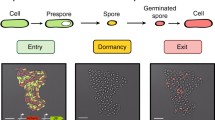Abstract
Recent timelapse microscopy studies suggest that endospore forming bacteria encounter a quantity-quality tradeoff: Bacillus subtilis can either make more or better spores. Natural isolates employ different life-cycle strategies that are beneficial under different revival conditions. These findings have implications for our understanding of the ecology and evolution of sporulating bacteria and their use in biotechnological applications.
Article PDF
Similar content being viewed by others
Avoid common mistakes on your manuscript.
Literatur
Paul C, Filippidou S, Jamil I et al. (2019) Bacterial spores, from ecology to biotechnology. Adv Appl Microbiol 9:79–111
Higgins D, Dworkin J (2012) Recent progress in Bacillus subtilis sporulation. FEMS Microbiol Rev 36:131–148
Setlow P, Wang S, Li Y (2017) Germination of spores of the orders Bacillales and Clostridiales. Annu Rev Microbiol 71:459–477
Mutlu A, Trauth S, Ziesack M et al. (2018) Phenotypic memory in Bacillus subtilis links dormancy entry and exit by a spore quantity-quality tradeoff. Nat Commun 9:69
Smith CC, Fretwell SD (1974) The optimal balance between size and number of offspring. Am Nat 108:499–506
Mutlu A, Kaspar C, Becker N, Bischofs IB (2020) A spore quality-quantity tradeoff favors diverse sporulation strategies in Bacillus subtilis. ISME J, https://doi.org/10.1038/s41396-020-0721-4
Earl AM, Losick R, Kolter R (2008) Ecology and genomics of Bacillus subtilis. Trends Microbiol 16:269–275
Durrett R, Miras M, Mirouze N et al. (2013) Genome sequence of the Bacillus subtilis biofilm-forming transformable strain PS216. Genome Announc 1:e00288–13
Schyns G, Serra CR, Lapointe T et al. (2013) Genome of a gut strain of Bacillus subtilis. Genome Announc 1:e00184–12
Serra CR, Earl AM, Barbosa TM et al. (2014) Sporulation during growth in a gut isolate of Bacillus subtilis. J Bacteriol 196:4184–4196
Babel H, Naranjo-Meneses P, Trauth S et al. (2020) Ratiometric population sensing by a pump-probe signaling system in Bacillus subtilis. Nat Commun 11:1176
Funding
Open Access funding enabled and organized by Projekt DEAL.
Author information
Authors and Affiliations
Corresponding author
Additional information
Danksagung
Mein besonderer Dank gilt meiner Arbeitsgruppe, insbesondere Alper Mutlu, und allen Kollaborationspartnern für ihre vielfältigen Beiträge sowie den Förderorganisationen (DFG, ERC, MPG).
Ilka Bischofs 1996–2001 Physikstudium an der Universität Würzburg und der State University of New York at Stony Brook, NY, USA. 2001–2004 Promotion (Physik) am Max Planck Institut für Kolloid- und Grenzflächen, Potsdam. 2005–2010 Postdoc, University of California, Berkeley/Lawrence Berkeley National Laboratory, CA, USA und Universität Heidelberg. 2010–2016 Emmy-Noether- und ERC-StG-Nachwuchsgruppe, Universität Heidelberg. Seit 2016 unabhängige Forschungsgruppe „Complex Adaptive Traits“ (CATs), Max Planck Institut für terrestrische Mikrobiologie/Universität Heidelberg.
Rights and permissions
Open Access Dieser Artikel wird unter der Creative Commons Namensnennung 4.0 International Lizenz veröffentlicht, welche die Nutzung, Vervielfältigung, Bearbeitung, Verbreitung und Wiedergabe in jeglichem Medium und Format erlaubt, sofern Sie den/die ursprünglichen Autor(en) und die Quelle ordnungsgemäß nennen, einen Link zur Creative Commons Lizenz beifügen und angeben, ob Änderungen vorgenommen wurden. Die in diesem Artikel enthaltenen Bilder und sonstiges Drittmaterial unterliegen ebenfalls der genannten Creative Commons Lizenz, sofern sich aus der Abbildungslegende nichts anderes ergibt. Sofern das betreffende Material nicht unter der genannten Creative Commons Lizenz steht und die betreffende Handlung nicht nach gesetzlichen Vorschriften erlaubt ist, ist für die oben aufgeführten Weiterverwendungen des Materials die Einwilligung des jeweiligen Rechteinhabers einzuholen. Weitere Details zur Lizenz entnehmen Sie bitte der Lizenzinformation auf http://creativecommons.org/licenses/by/4.0/deed.de.
About this article
Cite this article
Bischofs, I. Sporenbildung bei Bacillus subtilis: Masse oder Klasse?. Biospektrum 26, 606–608 (2020). https://doi.org/10.1007/s12268-020-1456-5
Published:
Issue Date:
DOI: https://doi.org/10.1007/s12268-020-1456-5




